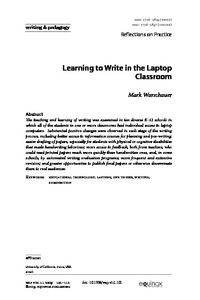Learning to Write in the Laptop ClassroomErstpublikation in: Writing & Pedagogy, Vol 1, No 1 (2009)
Publikationsdatum:
|
 |
 Diese Seite wurde seit 7 Jahren inhaltlich nicht mehr aktualisiert.
Unter Umständen ist sie nicht mehr aktuell.
Diese Seite wurde seit 7 Jahren inhaltlich nicht mehr aktualisiert.
Unter Umständen ist sie nicht mehr aktuell.
 Zusammenfassungen
Zusammenfassungen
 The teaching and learning of writing was examined in ten diverse K-12 schools in which all of the students in one or more classrooms had individual access to laptop computers. Substantial positive changes were observed in each stage of the writing process, including better access to information sources for planning and pre-writing; easier drafting of papers, especially for students with physical or cognitive disabilities that made handwriting laborious; more access to feedback, both from teachers, who could read printed papers much more quickly than handwritten ones, and, in some schools, by automated writing evaluation programs; more frequent and extensive revision; and greater opportunities to publish final papers or otherwise disseminate them to real audiences.
The teaching and learning of writing was examined in ten diverse K-12 schools in which all of the students in one or more classrooms had individual access to laptop computers. Substantial positive changes were observed in each stage of the writing process, including better access to information sources for planning and pre-writing; easier drafting of papers, especially for students with physical or cognitive disabilities that made handwriting laborious; more access to feedback, both from teachers, who could read printed papers much more quickly than handwritten ones, and, in some schools, by automated writing evaluation programs; more frequent and extensive revision; and greater opportunities to publish final papers or otherwise disseminate them to real audiences. The daily use of laptops in our 10 case study schools had a major effect on instruction at each stage of the writing process, including pre-writing, drafting, rewriting, and dissemination. Though the particular way that computers were used was shaped by the nature of K-12 schooling, and especially its emphasis on high-stakes testing, overall student writing in these schools became better integrated into instruction, more iterative, more public and collaborative, more purposeful and authentic, and more diverse in genre, while students’ written products improved in quality and student writing became more autonomous (for details, see Warschauer, 2006, 2008). One-to-one laptop use is not a magic bullet to solve all educational problems, but our study suggests that it has a substantial positive impact on the teaching and learning of writing. Educators who are concerned with promoting the kinds of writing and literacy skills required of 21st century life will do well to prioritize implementing one-to-one laptop programs in their classrooms.
The daily use of laptops in our 10 case study schools had a major effect on instruction at each stage of the writing process, including pre-writing, drafting, rewriting, and dissemination. Though the particular way that computers were used was shaped by the nature of K-12 schooling, and especially its emphasis on high-stakes testing, overall student writing in these schools became better integrated into instruction, more iterative, more public and collaborative, more purposeful and authentic, and more diverse in genre, while students’ written products improved in quality and student writing became more autonomous (for details, see Warschauer, 2006, 2008). One-to-one laptop use is not a magic bullet to solve all educational problems, but our study suggests that it has a substantial positive impact on the teaching and learning of writing. Educators who are concerned with promoting the kinds of writing and literacy skills required of 21st century life will do well to prioritize implementing one-to-one laptop programs in their classrooms. Dieser Text erwähnt ...
Dieser Text erwähnt ...
 Dieser Text erwähnt vermutlich nicht ...
Dieser Text erwähnt vermutlich nicht ... 
 Nicht erwähnte Begriffe | Bildung, Digitalisierung, Kinder, Schweiz, Unterricht |
 Tagcloud
Tagcloud
 Zitationsgraph
Zitationsgraph
 Zitationsgraph (Beta-Test mit vis.js)
Zitationsgraph (Beta-Test mit vis.js)
 2 Erwähnungen
2 Erwähnungen 
- One Laptop per Child Birmingham - Case Study of a Radical Experiment (Mark Warschauer, Shelia R. Cotten, Morgan Ames) (2012)


- Der Wiki-Weg des Lernens - Gestalten und Begleiten von Lernprozessen mit digitalen Kollaborationswerkzeugen (Michele Notari, Beat Döbeli Honegger) (2013)



 Anderswo finden
Anderswo finden
 Volltext dieses Dokuments
Volltext dieses Dokuments
 |  Learning to Write in the Laptop Classroom: Artikel als Volltext ( Learning to Write in the Laptop Classroom: Artikel als Volltext ( : :  , 169 kByte; , 169 kByte;  : :  Link unterbrochen? Letzte Überprüfung: 2021-03-21 Letzte erfolgreiche Überprüfung: 2014-08-28) Link unterbrochen? Letzte Überprüfung: 2021-03-21 Letzte erfolgreiche Überprüfung: 2014-08-28) |
 |  Learning to Write in the Laptop Classroom: Artikel als Volltext ( Learning to Write in the Laptop Classroom: Artikel als Volltext ( : :  , 169 kByte; , 169 kByte;  : :  Link unterbrochen? Letzte Überprüfung: 2021-03-21 Letzte erfolgreiche Überprüfung: 2012-08-07) Link unterbrochen? Letzte Überprüfung: 2021-03-21 Letzte erfolgreiche Überprüfung: 2012-08-07) |
 Anderswo suchen
Anderswo suchen 
 Beat und dieser Text
Beat und dieser Text
Beat hat Dieser Text während seiner Zeit am Institut für Medien und Schule (IMS) ins Biblionetz aufgenommen. Beat besitzt kein physisches, aber ein digitales Exemplar. Eine digitale Version ist auf dem Internet verfügbar (s.o.). Es gibt bisher nur wenige Objekte im Biblionetz, die dieses Werk zitieren.









 LehrerIn
LehrerIn Lernen
Lernen Notebook
Notebook Schreiben am Computer
Schreiben am Computer Schreiben von Hand
Schreiben von Hand Schule
Schule





 Biblionetz-History
Biblionetz-History